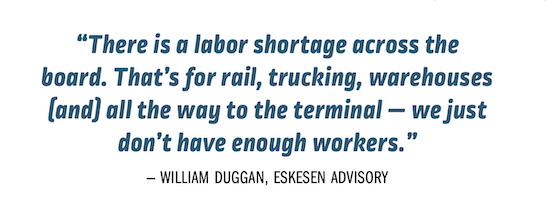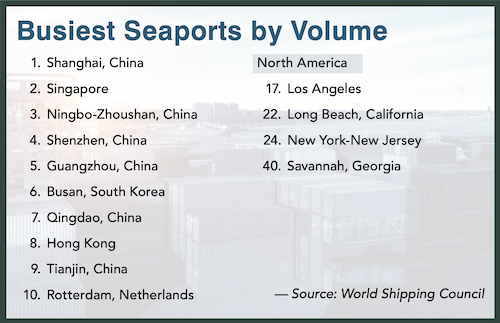Labor shortages at root of shipping, trucking mandates further issues
On Jan. 6, 2022, there were a record 105 shipping vessels anchored or loitering off the coast of Southern California waiting for openings to dock at the ports of Long Beach and Los Angeles.
On Jan. 6, 2021, there were 32.
Through the first eight months of 2021, having 32 vessels waiting was on the high side for the Southern California ports. Normally, it was in the teens or 20’s.
About the end of August is when numbers soared and breaking records became a common occurrence.
Los Angeles and Long Beach do more volume than any other seaports in the U.S. They are followed by New York-New Jersey and Savannah, Georgia, but the situation isn’t much better at either of those ports, nor are they at Seattle or Charleston, South Carolina.
It’s not just a struggle to get goods in and out of U.S. seaports, it’s a struggle to do so anywhere in the world, including through the major Chinese ports, Hong Kong and Rotterdam, Netherlands – Europe’s largest port.
Moving goods domestically throughout the U.S. also has become problematic. During the recent Potato Expo in Anaheim, California, Tracey Chow, a government affairs specialist for Western Growers, said members began complaining of shipping problems in late 2020, starting with nut growers. Things have only snowballed from there.
“Now that we’re a year into it, essentially every commodity has been affected,” Chow said. “Before it was just tree nuts, then it was citrus, then it was stone fruits (and other specialty crops). Now all the non-specialty crop commodities have been affected (i.e., soybeans, corn, etc.).
“They’re all getting hammered and probably even worse than California because they’re dealing with rail and trucking to get to the ports.”
Delays are frustrating and costly for everyone. When you’re moving a perishable product, such as fresh produce, delays result in loss of commodity and food waste.
“(Port delays have) led to fruit spoilage,” said Stewart Lapage, an Alberta, Canada-based logistics executive with The Oppenheimer Group. “Tens of thousands (containers) have spoiled before they have even touched the ground.”

Labor shortage big obstacle
Lapage was among the panelists during a recent International Fresh Produce Association (IFPA) virtual town hall on supply chain issues. Experts say the labor shortage is the first domino in what is a multifaceted array of problems in the current supply chain system. The pandemic has exasperated the situation, leaving many people unable, unauthorized or unwilling to work.
“There is a labor shortage across the board,” said William Duggan, the North American cold chain advisor for Eskesen Advisory. “That’s for rail, trucking, warehouses (and) all the way to the terminal – we just don’t have enough workers.”
Agriculture labor challenges are nothing new to growers, but the shortage of workers now extends to most industries in the supply chain, including cold chain facilities and packaging materials, much of which are imported from Asia.
“It all comes back to labor,” Lapage said.
There are about 5,000 shipping vessels worldwide. When hundreds are idle offshore and full of cargo, those ships and containers on them aren’t available to transport anything else.
“There are shippers in Brazil wondering when they’ll be able to ship a crop because they can’t find any containers,” Lapage said.
In North America, moving product by truck has been hampered by the well-documented driver shortage. Like in other industries, the pandemic has worsened worker availability.
Canadian officials recently implemented a full-vaccination mandate for U.S. truck drivers entering the country. The U.S. has a similar mandate for Canadian truckers. The Canadian Trucking Association estimates the mandates will affect about 12,000 U.S. and Canadian drivers. The current fully vaccinated rate was 78% in Canada and 63% in the U.S. at the time of this writing.
Lapage noted that unvaccinated drivers choosing to get the vaccine still have to wait two weeks until after their second dose to resume international driving.
“This is potentially catastrophic for Canada,” Lapage said. “We rely so heavily on U.S. (produce) imports. … Even drivers getting the vaccine now, you’re still looking at six weeks before they can resume cross-border freight.”
Freight option shortages and economic inflation have freight prices shooting up. Ed Treacy, the IFPA’s vice president of supply chain and sustainability, relayed an account from an apple shipper who recently paid $15,000 to move a load of apples from Washington state to Boston.
“That’s unheard of!” Treacy said.
Any relief in sight?
The panelists expect shipping congestion to continue at least through the third quarter of 2022 – possibly longer – and then the industry will have to catch up and recover.
Jeff Moore is the vice president of sales for the Midwest region for Tom Lange Companies, which includes Seven Seas, a global growing, packing and shipping operation, and Lange Logistics. Moore focuses on domestic shipping.
“The produce industry relies mostly on small fleets,” Moore said. “Not only do you have the driver shortage, but rising costs for these small fleets in the way of maintenance, tires, etc., are going to keep costs high, probably through 2023.
“We know demand is not going to taper off.”
While the seaports are moving to a 24-hour-per-day, seven-days-a-week business model, that won’t solve labor shortages or space and equipment availability elsewhere.
“It’s not a new problem in the fresh produce industry to not have enough cold storage in key markets like California, Florida and the Northeast,” Lapage said. “A lot of shippers want to build more, but there is a shortage of trade and land right now.”
Delays and rates will remain high for the foreseeable future, the panelists agreed. The volatility of the situation makes it hard to know how high to expect rates to rise.
When asked by an audience member how much companies should budget for freight, Moore said the situation is too unpredictable to give a long-term suggestion.
“Proceed with caution,” he said. “I would say shorten the length of time you want to budget for. Things are changing quickly, so shorten your cycle.”
Get commitments and contracts in place early, Lapage said. “Don’t wait until your current contract is up to start negotiating your new one,” he said. “Listen to your carriers about why the rates are what they are with labor costs and other factors, and be fair with them. Find a partner who wants to work with you, especially if they can offer you other services, like packaging or whatever.”
Having established partnerships with carriers and being a good customer are going to be especially valuable, given the scarcity of options.
“Right now it’s more important than ever to be the best shipper and best receiver,” Treacy said. “These drivers have a choice right now. If you don’t think you’re going to pay more than your neighbor who does respect appointment times and loading times, then you’re mistaken.
“If it (your reputation) is bad enough, you may get to a point where they refuse to haul for you.”
The IFPA is a new industry organization that was formed when the Produce Marketing Association and United Fresh Produce Association merged to form a new entity. It launched Jan. 1, 2022. IFPA holds weekly virtual town hall discussions at noon ET on Wednesdays. Visit freshproduce.org for more information.












